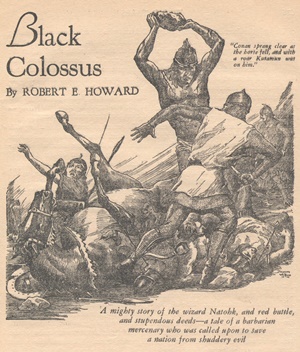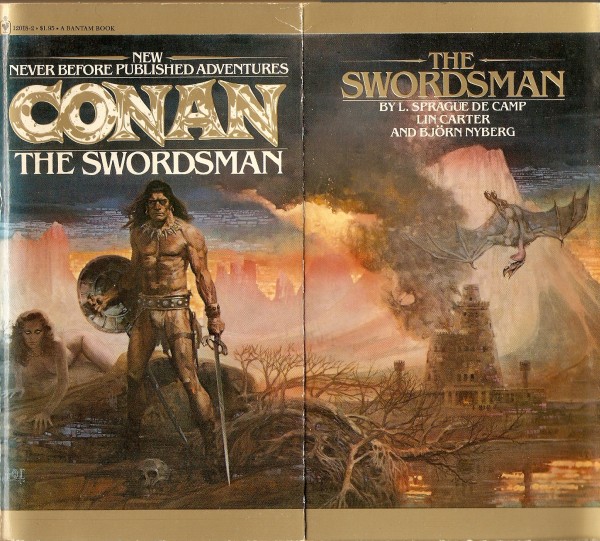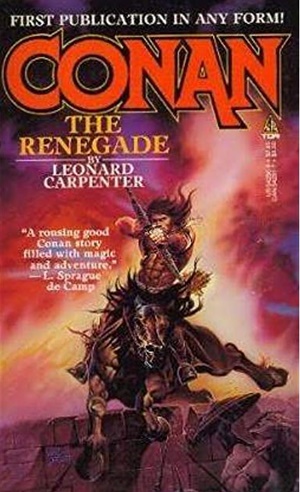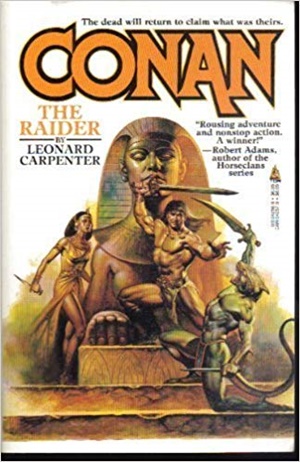Hither Came Conan: The Khoraja Saga
 Deuce Richardson will be looking into “Black Colossus” for Hither Came Conan. I wrote an essay last year for my friend James Schmidt’s Mighty Thor JR’s blog, looking at the expanded saga of the gem from that story. Surprisingly, it made the Preliminary List for the Robert E. Howard Foundation Awards! I’ve since read more Conan pastiches involving Khorajan affairs, and I expanded the original essay. So, here’s the updated version. My thanks to James for letting me appear over at his blog.
Deuce Richardson will be looking into “Black Colossus” for Hither Came Conan. I wrote an essay last year for my friend James Schmidt’s Mighty Thor JR’s blog, looking at the expanded saga of the gem from that story. Surprisingly, it made the Preliminary List for the Robert E. Howard Foundation Awards! I’ve since read more Conan pastiches involving Khorajan affairs, and I expanded the original essay. So, here’s the updated version. My thanks to James for letting me appear over at his blog.
Robert E. Howard was a master worldbuilder, as Jeffery Shanks wrote about over at Black Gate for the Discovering Robert E. Howard series. The history of Hyboria is sprinkled throughout his Conan tales, creating a vast backdrop, in both time and place. Conan’s own Cimmeria, Set-worshipping Stygia, the jungles of the Picts, mighty Aquilonia, fallen Acheron: it’s really amazing the depth and breadth that Howard created in the short story format (there was one novel, Hour of the Dragon, which drew on existing short stories – an approach used by Raymond Chandler a few years later: he called it ‘repurposing.’)
Khoraja is a small nation southeast of Koth. It isn’t one of the great countries of Hyboria, but it sat front and center for “The Black Colossus.” “Colossus” was the fourth published story to feature the Cimmerian, and one of five to find its way to print in Weird Tales in 1933. Editor Farnsworth Wright had rejected two others (“The Frost Giant’s Daughter” and “The God in the Bowl“) that would have added to that total. But before Conan enters the story in Khoraja, we get a little history from Howard.
Shevatas the thief is exploring the ruins of Kutchemes, once a great city and part of Stygia when its borders extended far beyond their present state (‘present’ in the Conan stories, that is…). Prior to Shevatas actually doing anything, we get this from Howard:
Eastward, Shevatas knew, the desert shaded into steppes stretching to the Hyrkanian kingdom of Turan, rising in barbaric splendor on the shores of the great inland sea. A week’s ride northward the desert ran into a tangle of barren hills, beyond which lay the fertile uplands of Koth, the southernmost realm of the Hyborian races. Westward the desert merged into the meadowlands of Shem, which stretched away to the ocean.
Look at the picture he painted with just three sentences of world building! There’s more before and after, but I absolutely love reading Howard’s description of the nations, past and present, in his stories. And he laid seeds for the pastiche writers that came after him. Not that such ever entered his mind.
Now, I’m about to unload a few spoilers, but if you haven’t already read a Robert E. Howard story from 84 years ago – well, I’m not sympathetic.
Shevatas’ final act (to mix my mythologies, he didn’t realize that the Norns were about to wrap things up for him) is to release Thugra Khotan, the last magician-ruler of Kutchemes. Now on the loose under the name of Natohk (not the most imaginative fellow, is he?), the not-so-dead wizard heads towards Khoraja to make Princess Yasmela his queen. He had been sending her terrifying visions and moves in to close the deal. She seeks Mitra’s aid and ends up getting Conan, working in Khoraja as a mercenary, to help her.
Long ago, Hyborian barbarians had ridden south and established a new kingdom named Koth. After helping to bring about the downfall of ancient Acheron, Koth became a nation of warring kingdoms and city-states. At some point, Kothic adventurers (most likely mercenaries) carved out a new kingdom from the lands of the Shemites. The city of Khoraja became its own mercenary-ruled nation, controlling the Shamla Pass, which was important to trade between the Hyborian kingdoms and the east and the south.
Khoraja is similar to one of the Crusader States of the Middle Ages. Chivalric knights are the backbone of the army. Much greater in number are the light cavalry, composed of hill men with bows. It’s like a combination of the Crusader knights and the Moslem horsemen they battled. Then there’s the foot spearmen – of Kothic blood but too poor to afford the accoutrements of knighthood.
I don’t believe that Khoraja appears again in Howard’s Conan tales. But because he had created such a rich world, similar yet different to our own past history, it’s a tapestry that other authors would draw on. And with that lead-in, I’m going to shift gears and look at The Khoraja Duology (man – that term just doesn’t work as well as ‘trilogy,’ does it?). With a third book that tells us a bit more about how things turned out there.
 I’ve written essays about, and reviews of, Conan stories written after Howard passed away. Known as pastiches (mostly sincere continuations of the character – rather than the more absurd parodies), the quality varies greatly. But one thing I like about the continuations of the saga is that they fill in many of the gaps of Conan’s career. Not just what Conan did, but they tie to some of Howard’s originals.
I’ve written essays about, and reviews of, Conan stories written after Howard passed away. Known as pastiches (mostly sincere continuations of the character – rather than the more absurd parodies), the quality varies greatly. But one thing I like about the continuations of the saga is that they fill in many of the gaps of Conan’s career. Not just what Conan did, but they tie to some of Howard’s originals.
The center of “Black Colossus” is Conan, now a general leading Khoraja’s forces, stopping Natohk and his invading army. Princess Yasmela rules in the absence of her brother, King Khossus. He is being held captive by the king of Ophir. Ophir is debating returning him for a large ransom, or turning him over to the king of Koth in exchange for an advantageous treaty. Khoraja loses either way (though I think Khossus prefers one option over the other). And while the nation tries to get its young king back, a seemingly undead sorcerer is leading a horde to its gates. Talk about a bad day at the office!
After a bloody battle (Howard was a master at epic battle scenes), Conan slays Natohk and rescues Yasmela, who lies naked on a black jade altar (Howard really liked naked women on altars, didn’t he?). He gathers her up and it’s unclear whether he ravishes her or the other way around. Thus ends “Black Colossus.”
I refer a lot to William Galen Gray’s chronology of Conan’s career. He has Conan at age 28 during “Black Colossus.” And in the chronology, the very next story, L. Sprague de Camp and Lin Carter’s “Shadows in the Dark,” is a direct sequel. Howard’s successors tell us what happened after Natohk’s death. This story is about forty years old, so once again, you’re on your own regarding spoilers.
Conan, staying on as head of the army, can’t get any alone time with Yasmela. She’s too busy being regent to satisfy his manly needs. Also, if rumors of her being bedded by a mere barbarian got loose – let alone if there were a pregnancy – it could prematurely end her interim reign. Conan tells her that if she marries him, it will solve everything, but she says that could never happen while she is regent. But perhaps she could talk her brother into allowing it if he were restored to his throne.
Conan decides to rescue Khossus from King Moranthes of Ophir, which will free up Yasmela’s time for him. Accompanied by an astrologer named Rhazes and a master thief with a grudge named Fronto, the trio travel through hostile Koth and reach the Ophirian capital of Ianthe. Along the way, Rhazes, who has some kind of shortwave astrology satellite or something like that, reveals himself to be much more dangerous than he appears when some bandits get the drop on the group.
Utilizing a secret underground tunnel, they reach Khossus’ cell. The king is revealed to be a young fool and frankly, a complete and total twit. First, he demands that his rescuer address him properly (they’re pulling him out of cell!), then he orders Conan (who is technically his general) to give him his sword. He will not leave until he has dueled with the captain of the guard, who has treated him poorly. Conan, tiring of this fop, slugs him in the jaw and carries him over his shoulder back out the escape route. That certainly can’t be good for his long term royal marriage prospects.
However, Rhazes turns out to be a traitor working for Koth and there are soldiers waiting for them at the area outside the tunnel. An enraged Fronto sinks his dagger into Rhazes as Conan attacks the enemy. A group of Ophirien prison guards emerge from the tunnel, see armed Kothians and attack. It’s a free-for-all as Conan and Khossus take advantage of a supernatural distraction and escape. Fronto is killed trying to get away with some loot.
BTW – Fronto, Taurus, Shevatas: being a master thief isn’t a guarantee of long life in Conan’s circles.
Camping on the way home, the king informs Conan that he is unfit to become a royal brother-in-law, being a ‘foreign barbarian and vulgar mercenary.’ The next day, while trying to express his gratitude, he informs Conan that he will find a middle-class maiden for Conan to marry, while arranging a royal betrothal for his sister.
And to top it off, Conan can’t go on ordering around knights and nobles. So, he’ll become an advisor to the new general, with a newly created position suitable for a commoner.
Khossus is one of the biggest idiots in the Conan saga. Granted, he is a de Camp and Carter personality, but still, if he were something less than a king, Conan would, at best, stuff him in a rainwater barrel outside of the inn. More likely, he would beat him to a pulp. Though that wouldn’t take long to do.
Conan briefly ponders killing him and fabricating a story about the king’s demise during the rescue attempt, but that would make the trip a complete waste. Also, he had given his word and honor is important to him. Also, he finds that he isn’t quite as keen on Yasmela as he had been.
Deciding that his time in Khoraja has come to an end, the brawny Cimmerian books the king passage on a ship that will get him most of the way home. Khossus had found an official willing to lend him 200 gold pieces, which he disdainfully gave to Conan to hold: “It becomes not the dignity of a monarch to carry filthy money.” I mean, seriously…
 As the ship casts off, Conan gives Khossus some (but apparently much less than half) of the gold and essentially bids him, “Good luck” and jumps back onto the pier. As Khossus splutters and cries out for his gold, Conan tells him he feels the need to see his homeland again. The king can consider the gold a reward and he can tell goodbye to his sister from Conan.
As the ship casts off, Conan gives Khossus some (but apparently much less than half) of the gold and essentially bids him, “Good luck” and jumps back onto the pier. As Khossus splutters and cries out for his gold, Conan tells him he feels the need to see his homeland again. The king can consider the gold a reward and he can tell goodbye to his sister from Conan.
So ends the story. While I do think that some of the de Camp and Carter pastiches are good, this one is rather ‘meh.’ I like that they tell ‘the rest of the story’ (I miss Paul Harvey) after “Black Colossus,” and it explains why Conan left Yasmela, but it’s not a rousing Conan adventure. On the plus side, I’m always interested in the politics of Hyboria, and the schemings of Koth, Khoraja and Ophir play a large part in this short story.
But Howard’s successors weren’t done with Khoraja. Leonard Carpenter wrote Conan the Renegade, the first of his eleven Conan novels. After Prince Ivor of the Corinthian city of Tantusium betrays the mercenaries in his employ, utilizing foul sorcery, Conan finds himself leader of the surviving companies as they flee and prepare to take their vengeance.
This debacle takes place about a year after Conan had left Khoraja. Now, most definitely in a tight spot, he meets with Yasmela again to seek aid. In true Conan fashion, he meets her in a fantastic manor, where she is swimming naked. And we get closure to our Khoraja saga.
After telling Conan to keep his big paws off of her, she then whines about her life. Her brother has become a dissolute wastrel, filling his days with pomp and pageantry and his nights with wine and women. Others rule in his stead and Yasmela has taken a more active role, letting Khossus think he is actually making the decisions. He even threatens to marry her off for an advantageous treaty.
Conan is less than enamored with her at this point.
As she laments the weak suitors she has dallied with, she contrasts them with Conan’s strength and honesty. Conan briefly wonders if killing Prince Ivor and crowning himself king of Tantusium would make him eligible to wed Yasmela. She doubts even that would be enough for her brother.
Then she turns on the charm and invites him to become her unofficial helper at the palace. In time, they could push Khossus aside and rule openly. When he points out that the nobility would object to him, she implies his mercenary army could quell any dissent. The situation is not resolved as they have sex through the night.
The next morning, Conan tells her that Khoraja can aid the mercenaries while the two can continue their secret assignations. When he flat out rejects her offer of the previous night, things change. She goes cold as a snow maiden and tells him that she will not permit his band to war on a neighboring kingdom then rush back to the safety of Khoraja. She informs him that if his mercenaries are not out of her country by the next day, she will declare them an invading force and attack them!
Conan accuses her of having reached this decision before he even arrived and walks out, making a cutting comment on her skill at court intrigues. His band of Free Companions move on. And that is the end of Conan’s dealings with the royal house of Khoraja. Well, sort of…
Conan has been king for an indeterminate time at the start of Leonard Carpenter’s Conan the Great. Nemedia and Ophir have joined forces and face Conan’s Aquilonian army on the Tybor Plain. It’s a difficult battle, but they lose. Back in Tarantia, Conan learns that Prince Armiro, satrap of Khoraja, has become self-styled ruler of Koth and wants a piece of Ophir as well.
Influenced by his new counselor (of dubious designs), Conan goes to war against Armiro and the two play a cat and mouse game of conquest. While on campaign, Conan is told that Yasmela was removed from court when Armiro came to power, and is held prisoner in some rural castle, removed from palace intrigues. Conan, in disguise, travels alone to the “rumor-haunted valley and down into the dark, ill-regarded tarn of the Tarnhold.
He survives a near-deadly encounter and finds Yasmela. The Tarnhold is actually a sumptuous castle: it’s enchanted to look forbidding from the outside. She is not a prisoner – she had retired from court. Though, likely with some encouragement from Armiro. Conan beds her.
 He awakes as Armiro and his men rush into the room. The two rulers duel one-on-one, back and forth, with Conan about to strike the killing blow. But he stays his hand for a moment when Yasmela cries out that Armiro is her son and begs Conan to spare him. The delay is telling, as the Supreme Tyrant’s men grab and subdue Conan.
He awakes as Armiro and his men rush into the room. The two rulers duel one-on-one, back and forth, with Conan about to strike the killing blow. But he stays his hand for a moment when Yasmela cries out that Armiro is her son and begs Conan to spare him. The delay is telling, as the Supreme Tyrant’s men grab and subdue Conan.
Armiro tells his mother that she’ll have to be removed somewhere more remote, to keep her from interfering in his affairs, while the Tarnhold will become Conan’s prison. Conan manages to escape with the help of a magic amulet he had taken from Yasmela earlier.
In her new prison, a nightmare creature enters her room and in eluding its gasp, she breaks through the glass window and plunges to her death.
Conan and Armiro confront each other at the bubbling pool of a once-powerful god, which now seeks to return to glory with one of them as his earthly champion. The women learn that Armiro is Conan’s son. After a fight in which Armiro despises his ‘new’ father, the two unite to battle the god, who is really a demon summoned by the dubious advisor mentioned earlier.
Conan plans to form an alliance with Armiro, leaving him an independent ruler.
One of the final stories in Conan’s chronology, this book brings the Khoraja Saga to a final close.
De Camp wasn’t shy about building on Howard’s stories (or doing far more with Howard’s writings…). He and Bjorn Nyborg wrote “The Star of Khorala,” which continued the story of the gem that was at the center of Howard’s “Shadows in Zamboula.” A few years later, Leonard Carpenter, fresh off of Conan the Renegade, dropped Conan the Raider directly between the events of “Shadows” and “Star,” forming ‘The Star of Khorala Trilogy.’
Likewise, de Camp and Carter’s “Moon of Blood” tells of what happened to Conan after Howard’s “Beyond the Black River” (hint: it involves Picts). It’s certainly a sequel and it is a better story than their “Shadows in the Dark.”
It’s not hard to find a bad Conan pastiche. But with a little digging, you can find good ones, like Conan the Raider, John Maddox Roberts’ Conan the Rogue and John C. Hocking’s Conan and the Emerald Lotus. But even in some of the less-than-stellar stories, there are elements that shine light on Howard’s world building and the stories he used for them. I think that gets lost in the frequent bashing of his successors.
Tying these stories to Howard’s originals and “picking up” Conan’s career adds a little veracity to the ‘other’ tales for me.
Prior posts in the series:
Here Comes Conan!
The Best Conan Story Written by REH Was…?
Bobby Derie on “The Phoenix in the Sword”
Fletcher Vredenburgh on “The Frost Giant’s Daughter”
Ruminations on “The Phoenix on the Sword”
Jason M Waltz on “The Tower of the Elephant”
John C. Hocking on “The Scarlet Citadel”
Morgan Holmes on “Iron Shadows in the Moon”
David C. Smith on “The Pool of the Black One”
Dave Hardy on “The Vale of Lost Women”
Bob Byrne on Dark Horse’s “Iron Shadows in the Moon”
Jason Durall on “Xuthal of the Dusk”
Scott Oden on “The Devil in Iron”
James McGlothlin on “The Servants of Bit-Yakin”
Fred Adams on “The Black Stranger”
Stephen H. Silver on “Man Eaters of Zamboula”
Keith J. Taylor on “Red Nails”
Ryan Harvey on “Hour of the Dragon”
The Animated Red Nails Movie that Never Happened
Mark Finn on “The God in the Bowl”
Bob Byrne on “Rogues in the House”
 Bob Byrne’s ‘A (Black) Gat in the Hand’ was a regular Monday morning hardboiled pulp column from May through December, 2018.
Bob Byrne’s ‘A (Black) Gat in the Hand’ was a regular Monday morning hardboiled pulp column from May through December, 2018.
His ‘The Public Life of Sherlock Holmes’ column ran every Monday morning at Black Gate from March, 2014 through March, 2017 (still making an occasional return appearance!).
He also organized Black Gate’s award-nominated ‘Discovering Robert E. Howard’ series.
He is a member of the Praed Street Irregulars, founded www.SolarPons.com (the only website dedicated to the ‘Sherlock Holmes of Praed Street’) and blogs about Holmes and other mystery matters at Almost Holmes.
He has contributed stories to The MX Book of New Sherlock Holmes Stories – Parts III, IV, V and VI.
And he is in a new anthology of new Solar Pons stories, out now.
Very nice article, Bob. Though it looks like not so many people are interested in commenting on Howard pastiche as Howard himself, based on the dearth of responses over the past few days.
I didn’t know Yasmela appeared in Conan the Renegade, one of the many, many Tors I haven’t read. Will have to look up that one.
Those who haven’t read Conan the Great will likely wonder who “the women” are who learn Armiro is Conan’s son, since the only one you mention, Yasmela, has just died. For the record, they’re Conan’s queen Zenobia and Yasmala’s maid Vateesa, who survived her mistress’s murder to go tell Zenobia, who then got them both to the warring royal idiots to clue them in before they manage to achieve a Rustam/Sohrab tragedy.
Conan the Great is a problematic novel. On the one hand, it’s the only one Tor set in the time of Conan’s kingship and the only one to take up Howard’s suggestion that Conan might have been forced into an attempt at world conquest, which he might either win or perish in. (Per Carpenter, neither.) On the other, the plot relies on Conan suffering an unlikely midlife crisis (“Oh no! I’m getting old! What am I going to dooooo…”), getting easily duped by an evil dwarf (“Why not conquer the world as stooge for me and my evil demon-god? Hey, we’ll even help!”), and basically acting like a real dick. Very out of character. (And abandoning an ongoing campaign to go rescue an old flame and hit her up for information, which is … rather more in character.) Also, Armiro is, literally, an evil bastard whose word can’t be counted on until (maybe) he finds out who his daddy is. He’s basically Conan without the good qualities. The two may be working on a diplomatic solution to their differences at the end of the book, but that boy’s gonna need watching.
That said, there’s a lot to admire in the big and small picture of Hyborian Age warfare Carpenter gives us, and the plotline is more intricate than we often get in the Tors, even if a bit creaky in its operation, and dependent on the author trying to put one over on the reader. (He disguises Vateesa’s mission to Zenobia as a second visitation by the entity that did in Yasmela.)
One quibble: William Galen Gay is actually named William Galen Gray.
Sorry to leave you guys alone here but I have to admit that I just haven’t read most of the pastiche books out there. I was completely in the dark regarding the Khoraja saga for example.
Thanks Bob, for bringing me up to speed.
I’d like to see Leonard Carpenter write a new Conan novel for Perilous Worlds. I generally enjoy his Tor books.
All very interesting, Bob, thanks for laying this all out. However, as John said above, I haven’t read most of the pastiche and this definitely doesn’t excite me to make the attempt. I have Wagner’s and Anderson’s and always meant to read them, and I want to read Hocking’s, so now that both his tales are coming out I might finally get that chance.